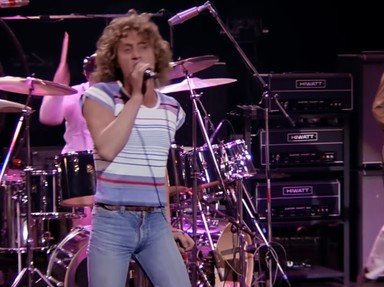Quiz Answer Key and Fun Facts
1. The Who began as a band called The Detours, who started out in 1961. Roger Daltrey started the band as guitarist and recruited bassist John Enwistle in 1962. Entwistle then suggested an additional guitarist, a fellow by the name of Pete Townshend, a school and band friend of his. The lead singer for The Detours was Colin Dawson. Before Keith Moon joined this band, who was the drummer for then The Detours?
2. In May 1964, The Who had their first manager. What was the manager's name?
3. Pete Townshend began writing songs for the group (later he would be famous for being a songwriter). The first big song he wrote was "I Can't Explain", a song that had The Kinks musical style. When Townshend wrote this song to The Kink's music, he wanted to attract the producer of The Kinks. Who was the producer of The Kinks?
4. The Who released another album shortly after their "My Generation" one. The album was entitled "A Quick One", and featured the mini-rock opera "A Quick One While He's Away", which was written by Pete Townshend. How many songs did Keith Moon write on this album?
5. The Who's next album was "The Who Sell Out". The album cover featured Pete Townshend putting on some deoderant and Roger Daltrey in a bathtub filled with what?
6. When "Tommy" was released it was only a moderate hit. When The Who played it on stage, however, it became the highlight of their show. Soon after playing it at Woodstock, "Tommy" became world-famous with hits like "See Me, Feel Me", "I'm Free", and the ever-so-popular "Pinball Wizard". In 1975, the highly successful "Tommy" was made into a movie with the same title as the album. It featured many stars like Jack Nicholson, Tina Turner, and Elton John. Who played Uncle Ernie in the film?
7. "Who's Next" was released in 1971, and was considered one of the greatest Who albums ever. All the songs off the album were written by Pete Townshend, except for "My Wife" which was written by John Entwistle. The opening song on "Who's Next" was "Baba O' Riley", named after Meher Baba. Baba was Townshend's spiritual geru. It was also named after Steve O' Riley, a musician who influenced Townshend. Another theory is that the O' Riley part is another name for the violin jig at the end of the song. Speaking of violins, who performs the violin jig at the end of the song?
8. After the incredible popularity of "Who's Next", Pete Townshend began working on the next Who rock opera (soon titled "Quadrophenia). It was originally going to be about the history of The Who, but after some changes, Townshend decided to make the rock opera a story about a Who fan. What was the name of this Who fan?
9. At a Madison Square Garden concert held in June, 1974, Pete Townshend discovered that the passion in performing with The Who began to fade for him. This led to the next Who album, titled "The Who By Numbers". Not as successful as their other albums, "The Who By Numbers" features the song "Squeezebox". The song was released as a single and hit number 10 on the UK Charts. What number did the song hit in the US?
10. The hit song "Who Are You" was the title track of The Who's next album. "Who Are You" was written as if a man was praying to God asking "Who are you?". This song was also the theme song used on what TV show?
11. After the tragedy of Moon's death, many thought The Who should have called it quits, but they had too many projects going to break up. Instead, the filled the drummer's seat with Kenny Jones, ex-drummer of the Small Faces and a friend of Pete Townshend's and John Entwistle's. His style of drumming was different from Moon's, which led to his rejection by many Who fans. The Who also added a keyboardist. What was the keyboardist's name?
12. The first Who album without Keith Moon was released, entitled "Face Dances". This album contained the hit single "You Better You Bet". However, this album got cruel reviews from critics, and some say it sounded like left over tracks off of Townshend's "Empty Glass" album. What year was the album "Face Dances" released?
13. "It's Hard", The Who's final album, got bad reviews. Like "Face Dances", the critics and many Who fans disparaged it. The only hit song off the album was "Eminence Front". Which of the following lines listed below is NOT mentioned in the song "Eminence Front"?
14. The Who had a tour in the US and Canada and later was billed as The Who's farewell concert. But The Who were supposed to record one more album to fulfill their contract. Townshend began working on an album called "Siege", but abandoned it soon. He met with the other band members and told them that he felt he couldn't write songs for the band anymore. After obtaining an early settlement of their record contract, Townshend called a press conference and announced the end of The Who. What year was the breakup of The Who?
15. The Who are still touring and attempting to make some more albums, but there came a period in time where they would take a big break, or as people thought of it then, the break-up of the band. When Townshend announced this "break-up", how many years had the Who been a band?
Source: Author
thewho13rd
This quiz was reviewed by FunTrivia editor
Dalgleish before going online.
Any errors found in FunTrivia content are routinely corrected through our feedback system.

